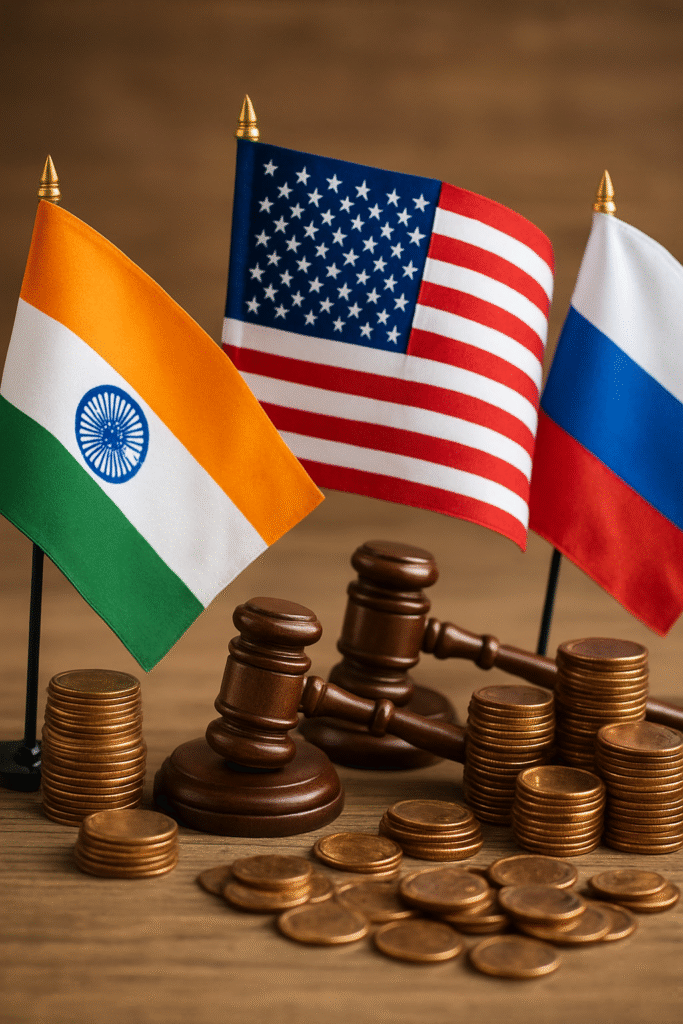America’s Tariff on India : The recent U.S. announcement imposing significant new tariffs on key Indian imports like steel, aluminum, and certain electronics has sent shockwaves through diplomatic and trade circles. As a professional U.S. blogger closely tracking this unfolding drama, I find myself – and many readers – asking: Why is America so keen to impose tariffs on India, a crucial democratic partner, while its own trade ties with sanctioned nations like Russia raise eyebrows? Let’s dissect the complex layers behind this decision, the glaring contradictions, and the realpolitik driving Washington’s actions in August 2025.

Step 1: The Spark – What Just Happened?
On August 3rd, 2025, the U.S. Trade Representative (USTR) finalized tariffs ranging from 15% to 25% on $3.2 billion worth of Indian goods. The official justification? Addressing “unfair trade practices,” including alleged subsidies to Indian exporters and intellectual property concerns in the tech sector. This move follows a tense year of negotiations that failed to yield a breakthrough.
- Official USTR Statement: “These actions are necessary to level the playing field for American workers and industries facing unfair competition.” (USTR Press Release, August 3, 2025)
- Immediate Indian Reaction: India’s Commerce Minister called the tariffs “discriminatory” and warned of “calibrated countermeasures,” signaling a potential trade war.

Step 2: The Stinging Contradiction – U.S. Reliance on Russian Imports
The elephant in the room is undeniable: How can America justify punishing India for trading with Russia while continuing significant imports from Russia itself? This perceived hypocrisy is fueling outrage in New Delhi and skepticism among global observers.
- The Reality of U.S.-Russia Trade (2024-2025): Despite sanctions imposed after the 2022 Ukraine invasion, the U.S. legally continues importing specific Russian goods under waivers granted for “national interest” or lack of viable alternatives. Key imports include:
- Nuclear Fuel (Uranium): Critical for U.S. nuclear power plants. The U.S. imported approximately $1.1 billion worth of enriched uranium from Russia in 2024, accounting for roughly 24% of its supply. (U.S. Energy Information Administration (EIA), Annual Uranium Report 2025). This trade continues under specific waivers from U.S. sanctions.
- Titanium Sponge: Vital for aerospace (Boeing, Lockheed Martin). Russia remains a major global supplier. U.S. imports in 2024 were valued around $350 million. (U.S. Geological Survey (USGS), Mineral Commodity Summaries 2025 – Titanium).
- Palladium & Platinum Group Metals: Essential for catalytic converters (auto industry) and electronics. U.S. imports from Russia totaled approximately $200 million in 2024. (U.S. International Trade Commission (USITC) DataWeb).
- Fertilizer Potash: Critical for U.S. agriculture. While significantly reduced, limited imports under sanctions waivers continued into early 2025, valued at $85 million in 2024. (USDA Foreign Agricultural Service, Global Agricultural Trade System).
- The Double Standard Perception: India argues its purchases of discounted Russian oil (heavily reduced since 2022) are essential for energy security and inflation control for its 1.4 billion people, similar to the U.S. reliance on Russian uranium for critical energy infrastructure. India has also significantly diversified its oil sources since 2023. Yet, it faces tariffs, while U.S. imports deemed “critical” continue.

Step 3: Beyond Trade Deficits – The Real Reasons America is Imposing Tariffs on India?
While the USTR cites trade practices, analysts point to deeper, intertwined factors driving the America tariff on India:
- Geopolitical Leverage & Russia Ties: This is the unspoken giant. The U.S. remains deeply frustrated by India’s refusal to fully align with the West against Russia. India’s continued defense purchases (like the S-400 systems) and economic engagement with Moscow are seen as undermining Western sanctions. The tariffs are widely interpreted as a tool to pressure India into reducing ties with Russia. Former State Department official Alyssa Ayres (now at CFR) stated: “The tariffs send a clear, albeit painful, signal: Washington expects strategic partners to share burdens on core security issues like confronting Russia. Trade policy is increasingly foreign policy.” (Council on Foreign Relations Analysis: U.S.-India Relations in 2025).
- Domestic Political Pressures: 2025 is a pre-election year atmosphere in the U.S. Key battleground states like Ohio, Pennsylvania, and Indiana have significant steel and manufacturing sectors. Imposing tariffs resonates with voters concerned about jobs and “fairness,” even if economists warn of inflationary costs. “This is classic political economy,” argues economist Paul Krugman. “The concentrated benefits (protected industries) outweigh the diffuse costs (higher prices for consumers) in the political calculus, especially when you can frame it as standing up for American workers against unfair competition.” (The New York Times – Krugman Archive).
- Containing China – The Complex Angle: The U.S. sees India as a vital counterweight to China. However, there’s concern that cheaper Indian exports, potentially using Chinese components or benefiting from state support, could flood the U.S. market and undermine American manufacturing competitiveness vis-à-vis China. Tariffs aim to protect U.S. industry while encouraging India to align more closely with U.S. supply chain initiatives like the “Indo-Pacific Economic Framework” (IPEF), reducing reliance on China. USTR Katherine Tai has repeatedly emphasized “building resilient, fair supply chains with trusted partners.” (USTR Indo-Pacific Economic Framework).
- Intellectual Property & Digital Trade Frictions: The U.S. tech industry lobbies hard against India’s policies on data localization, digital taxation (like the Equalization Levy), and patent regulations (especially in pharmaceuticals). The tariffs include pressure points on electronics and tech-related goods, directly linking trade penalties to these unresolved disputes.
- Addressing the Persistent Trade Deficit: While not the sole driver, the U.S. goods trade deficit with India (around $45 billion in 2024) provides a tangible justification. The U.S. aims to reduce this deficit by making Indian exports less competitive, hoping to boost domestic production and exports to India. (U.S. Census Bureau – Trade in Goods with India).
Step 4: Voices from the Arena – What Prominent Figures Are Saying
- U.S. Perspective (Official): “Our actions are consistent with WTO principles and necessary to address decades of market distortions. We continue to value the strategic partnership with India and hope for constructive dialogue.” – Spokesperson, U.S. Department of State.
- U.S. Perspective (Critical): “The hypocrisy is glaring. We carve out massive exceptions for Russian uranium vital to our grid but penalize India for oil it needs to keep its economy running. This undermines our moral authority and pushes India closer to Russia and China.” – Senator Chris Murphy (D-CT), Senate Foreign Relations Committee Hearing, July 2025.
- Indian Perspective (Official): “These unilateral tariffs are unacceptable and violate the spirit of our strategic partnership. India has always engaged fairly and is willing to address genuine concerns through dialogue, not coercion. We note with concern the ongoing U.S. imports from Russia.” – Official Statement, Ministry of Commerce & Industry, India. (Ministry of Commerce & Industry Press Releases).
- Indian Perspective (Analytical): “This is less about trade and more about arm-twisting India on global geopolitics. The U.S. wants India to abandon its strategic autonomy, particularly regarding Russia, and fall completely into its orbit. The tariffs are a blunt instrument that will damage trust.” – C. Raja Mohan, Senior Fellow, Asia Society Policy Institute. (Asia Society Policy Institute Commentary).
- International Observer: “The U.S.-India trade spat reveals the fragility of the ‘free trade’ order when strategic rivalries intensify. The U.S. is weaponizing trade to achieve geopolitical goals, while India feels targeted for pursuing its legitimate national interests. Both sides risk significant economic self-harm.” – The Economist Intelligence Unit (EIU) Update, August 2025. (EIU Country Reports)
Step 5: The Road Ahead – Escalation or Resolution?
The immediate future looks rocky:
- India’s Likely Response: Retaliatory tariffs on iconic U.S. exports like apples, almonds, machinery, and potentially Harley-Davidson motorcycles are being finalized. This could hurt U.S. farmers and manufacturers.
- WTO Challenges: India is almost certain to challenge the U.S. tariffs at the World Trade Organization (WTO), arguing they are protectionist and violate rules.
- Impact on Broader Ties: The Quad (US, India, Japan, Australia) cooperation could suffer, and defense deals might face delays or reconsideration. Trust, a key pillar of the partnership, is eroding.
- Potential for Dialogue: Backchannel talks are reportedly ongoing. A face-saving solution could involve India offering minor concessions on market access or IP while quietly seeking ways to further reduce Russian energy dependence, coupled with a U.S. pause on implementing some tariffs. However, the fundamental geopolitical divergence on Russia remains a massive hurdle.
Conclusion: A Tangle of Trade, Power, and Principle
The America tariff on India is far more than a simple dispute about steel subsidies or market access. It’s a high-stakes clash where trade policy is being wielded as a tool of geopolitical coercion. The undeniable U.S. reliance on Russian imports – particularly uranium vital for its own energy needs – creates a perception of hypocrisy that undermines Washington’s moral stance.
While legitimate trade concerns exist, the timing and scale of the tariffs point overwhelmingly to a U.S. attempt to pressure India into aligning more closely against Russia and to appease domestic political constituencies. The risk is significant: damaging a vital strategic partnership, fueling inflation in both countries, and weakening the rules-based international order.
As we move deeper into 2025, the world watches whether these two great democracies can navigate this complex tangle of competing interests – national security, economic fairness, strategic autonomy, and global leadership – without causing lasting damage to a relationship crucial for the stability of the Indo-Pacific and beyond. The resolution, or lack thereof, will have profound implications far beyond bilateral trade statistics.
What do you think? Is the U.S. justified in using tariffs to pressure India geopolitically? Or is this a case of blatant hypocrisy that will backfire? Share your thoughts in the comments below – let’s have a respectful discussion!
Disclaimer: The views expressed in this blog post are solely those of the author as an independent commentator and do not represent the official position of any government or organization. Information is based on publicly available sources and analysis current as of August 2025. Trade policies are complex and subject to rapid change. Readers are encouraged to consult official sources (linked throughout) for the latest updates and data. All images used in this article are royalty‑free or licensed for commercial use and are provided here for illustrative purposes.
